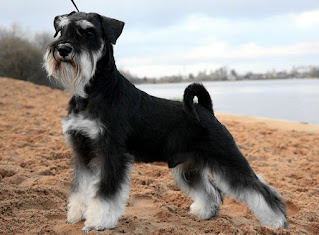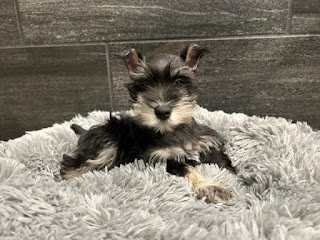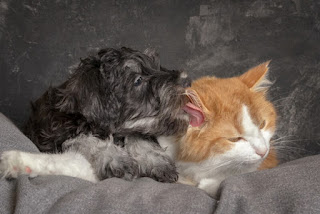Dogs are best friends for humans, providing companionship, loyalty, and love. Choosing a new puppy is a thrilling and rewarding experience, with each breed offering unique characteristics. The process involves careful research to ensure compatibility with your lifestyle, preferences, and household dynamics. If you are looking for a new breed, we would suggest the Schnauzer is ranked in the top 20 most popular breeds in the United States. The three types of Schnauzer give you more choice to choose what would fit with your lifestyle. Here we will provide you with everything you need to know about essential care needs, such as nutrition, understanding the breed's temperament, energy level, care requirements, vaccination and tips for introducing your new furry friend to existing pets in the household.
Why Choose a Schnauzer?
Schnauzers are renowned for their intelligence, loyalty, and affectionate nature, making them an excellent choice for first-time puppy owners. Their versatile size options, including Miniature, Standard, and Giant Schnauzers, cater to various living situations and preferences. Whether you're seeking a compact companion for apartment living or a larger, more robust dog for outdoor activities, there's a Schnauzer size to suit your needs. you will find more about the Schnauzer types in this article.
Choosing the Right Schnauzer
When selecting a Schnauzer puppy, consider factors such as size, temperament, and energy level to ensure compatibility with your lifestyle. Miniature Schnauzers You can bring it almost anywhere. On the train ride, to a family reunion, etc. All of these things are a whole lot easier, with a small dog. well-suited for apartment dwellers and families with limited space. For a woman, these dogs are often a bit too much; they are less powerful, so they don't pull as hard; they are perceived as less aggressive. while Standard and Giant Schnauzers thrive in larger homes with ample outdoor areas for exercise.
Early Nutrition: Setting the Foundation
Nutrition plays a crucial role in your Schnauzer puppy's growth and development. Start by choosing a high-quality puppy food formulated specifically for small or medium breeds, depending on the size of your Schnauzer. Consult your veterinarian for recommendations on feeding schedules and portion sizes to meet your puppy's nutritional needs during this critical stage of growth. More detail about dray food for Schnauzer Here...
The Importance of Veterinary Visits
Regular veterinary check-ups are essential for monitoring your Schnauzer puppy's health and addressing any concerns early on. Schedule your puppy's first veterinary visit shortly after bringing them home to establish a baseline of health and discuss vaccinations, deworming, and preventative care measures.
Hair Care
Schnauzers have a distinctive double coat that requires regular grooming to prevent matting and maintain their signature appearance. Regular grooming helps maintain coat quality and prevents tangles. However, the Sheltie can also be groomed in a shorter "puppy cut" style, which greatly reduces the amount of grooming required. Invest in quality grooming tools such as a slicker brush, comb, and grooming scissors to keep your Schnauzer's coat neat and tidy. Schedule professional grooming appointments as needed to trim their beard, eyebrows, and body coat.
Choosing the Right Bed for Your Puppy
Provide your Schnauzer puppy with a comfortable and secure sleeping area to promote restful sleep and relaxation. Opt for a cozy dog bed or crate that accommodates their size and provides ample cushioning and support. Place the bed in a quiet corner of your home away from high-traffic areas to create a peaceful retreat for your puppy.
train your Schnauzers
Schnauzers are intelligent dogs known for their resourcefulness and eagerness to please their owners. While they may show a hint of stubbornness at times, it's not as bad as Huskies and Shelties. It can be overcome through consistent and positive reinforcement training methods. It is recommended to start training at an early age. Begin by teaching your Schnauzer basic commands such as "sit," "stay," "down," and "come." Schnauzers respond well to positive reinforcement methods, so focus on rewarding desired behaviors.
Selecting Toys for Your Schnauzer
Schnauzer puppies are curious and playful by nature, so it's essential to provide them with a variety of toys to keep them mentally and physically stimulated. Choose toys made from durable materials such as rubber or nylon to withstand vigorous chewing and play. Interactive toys such as puzzle feeders and treat-dispensing toys can also help engage your puppy's mind and prevent boredom.
Introducing Your Schnauzer to Existing Pets
Introducing a new puppy to your household can be an exciting but potentially challenging experience for existing pets. Take gradual steps to introduce your Schnauzer puppy to other animals, starting with scent swapping and supervised meetings in neutral territory. Monitor interactions closely and provide positive reinforcement to encourage friendly behavior and prevent conflicts.
Bringing home a Schnauzer puppy is a rewarding journey filled with love, laughter, and companionship. By following the tips and guidelines outlined in this guide, first-time puppy owners can ensure a smooth transition for their new furry friend and lay the foundation for a lifelong bond built on trust, respect, and mutual happiness.
FAQ
How to Identify a Miniature Schnauzer?
Miniature Schnauzers are known best for facial hair, especially their bushy mustache and beard.
How to Know Your Schnauzer Puppy Is Miniature, Standard or Giant?
- Easy way by their size:Mini is around 1 ft (30 cm) tall at the shoulder and weighs between 14 and 20 lb (6.4 and 9.1 kg).
- Standard is around 1.5 ft (46 cm) tall at the shoulder and weighs 30 to 45 lb (14 to 20 kg).
- Giant is around 2 ft (61 cm) tall at the shoulder and weighs between 55 and 80 lb (25 and 36 kg).
Do Schnauzers Get Along With Other Pets?
Yes. Their basic natures include connecting, being social, involved and interactive. All the makings for a great companion. Early socialization is crucial for dogs to learn how to interact appropriately with other animals.

(1).jpg)







0 Comments